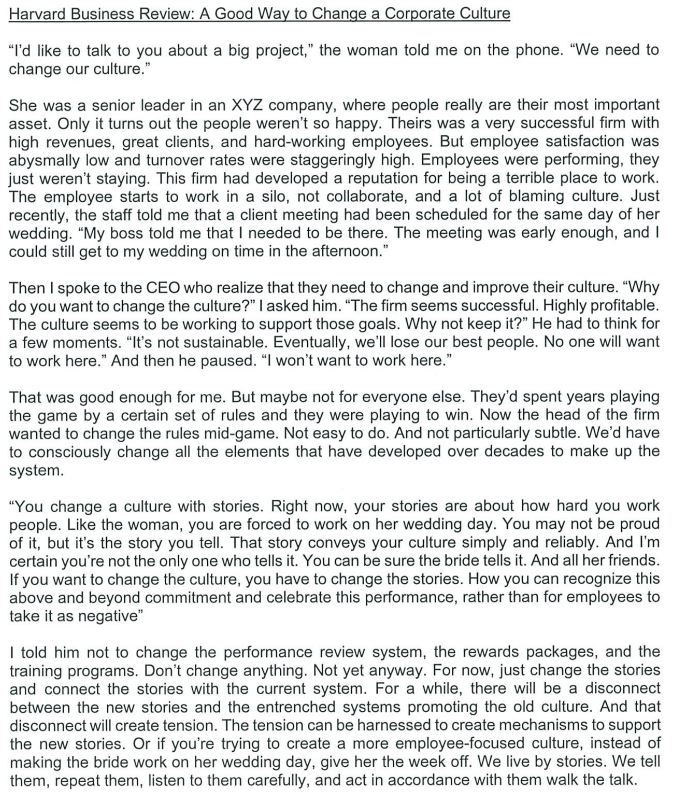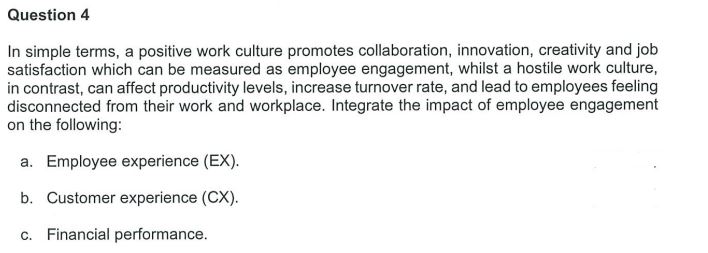Answered step by step
Verified Expert Solution
Question
1 Approved Answer
Harvard Business Review: A Good Way to Change a Corporate Culture I'd like to talk to you about a big project, the woman told



Harvard Business Review: A Good Way to Change a Corporate Culture "I'd like to talk to you about a big project," the woman told me on the phone. "We need to change our culture." She was a senior leader in an XYZ company, where people really are their most important asset. Only it turns out the people weren't so happy. Theirs was a very successful firm with high revenues, great clients, and hard-working employees. But employee satisfaction was abysmally low and turnover rates were staggeringly high. Employees were performing, they just weren't staying. This firm had developed a reputation for being a terrible place to work. The employee starts to work in a silo, not collaborate, and a lot of blaming culture. Just recently, the staff told me that a client meeting had been scheduled for the same day of her wedding. "My boss told me that I needed to be there. The meeting was early enough, and I could still get to my wedding on time in the afternoon." Then I spoke to the CEO who realize that they need to change and improve their culture. "Why do you want to change the culture?" I asked him. "The firm seems successful. Highly profitable. The culture seems to be working to support those goals. Why not keep it?" He had to think for a few moments. "It's not sustainable. Eventually, we'll lose our best people. No one will want to work here." And then he paused. "I won't want to work here." That was good enough for me. But maybe not for everyone else. They'd spent years playing the game by a certain set of rules and they were playing to win. Now the head of the firm wanted to change the rules mid-game. Not easy to do. And not particularly subtle. We'd have to consciously change all the elements that have developed over decades to make up the system. "You change a culture with stories. Right now, your stories are about how hard you work people. Like the woman, you are forced to work on her wedding day. You may not be proud of it, but it's the story you tell. That story conveys your culture simply and reliably. And I'm certain you're not the only one who tells it. You can be sure the bride tells it. And all her friends. If you want to change the culture, you have to change the stories. How you can recognize this above and beyond commitment and celebrate this performance, rather than for employees to take it as negative" I told him not to change the performance review system, the rewards packages, and the training programs. Don't change anything. Not yet anyway. For now, just change the stories and connect the stories with the current system. For a while, there will be a disconnect between the new stories and the entrenched systems promoting the old culture. And that disconnect will create tension. The tension can be harnessed to create mechanisms to support the new stories. Or if you're trying to create a more employee-focused culture, instead of making the bride work on her wedding day, give her the week off. We live by stories. We tell them, repeat them, listen to them carefully, and act in accordance with them walk the talk. QUESTION 1 Solutions, innovations and new ideas start with the problem. In a high-performance culture organization, problems can be seen as opportunities to improve and enhance. Based on the above case study, answer the following questions: a. Identify THREE (3) problems in the organization and support your answer with examples of the behaviors. b. Appraise the problems and explain the impact on the business, process and people. QUESTION 2 Cultural change is the process in which an organization encourages employees to adopt behaviors and mindsets that are consistent with the organization's values and goals. Cultural change may be necessary to better align the behaviors of employees with current and future business objectives, leadership aspirations and productivity enhancement. Propose the new values, mission and vision together with the descriptors for the XYZ company. QUESTION 3 Based on the new values, mission and vision, design the annual initiatives for the culture socialization campaign by referring to the following: a. The culture has to be defined in actionable behaviors. b. The employees need feedback on how well they are doing. c. The employees needed to be guided on how to apply those behaviors in their day-to- day jobs. Question 4 In simple terms, a positive work culture promotes collaboration, innovation, creativity and job satisfaction which can be measured as employee engagement, whilst a hostile work culture, in contrast, can affect productivity levels, increase turnover rate, and lead to employees feeling disconnected from their work and workplace. Integrate the impact of employee engagement on the following: a. Employee experience (EX). b. Customer experience (CX). c. Financial performance.
Step by Step Solution
There are 3 Steps involved in it
Step: 1
Question 1 a Identify THREE 3 problems in the organization and support your answer with examples of the behaviors 1 Low Employee Satisfaction and High Turnover Rates Behavioral Example Employees feeli...
Get Instant Access to Expert-Tailored Solutions
See step-by-step solutions with expert insights and AI powered tools for academic success
Step: 2

Step: 3

Ace Your Homework with AI
Get the answers you need in no time with our AI-driven, step-by-step assistance
Get Started


